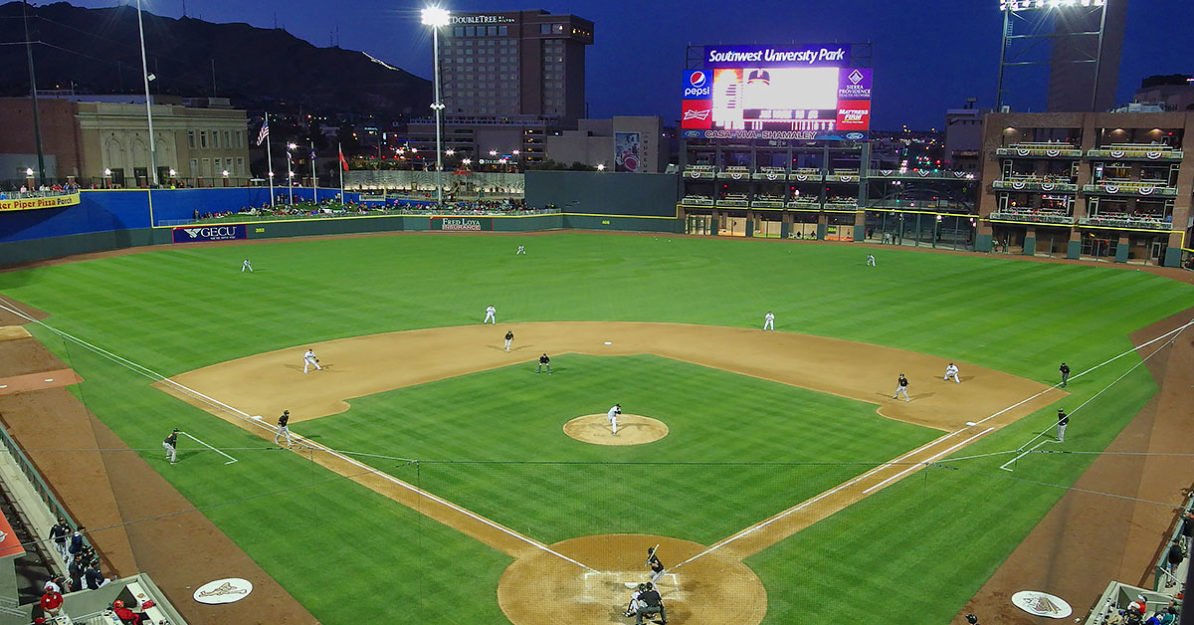Article and all photos by Joe Mock, BaseballParks.com
All rights reserved
When Safeco Field opened midway through the 1999 season, it was hailed as both an engineering and aesthetic achievement, and deservedly so. One of its most noteworthy features, though, had nothing to do with its retractable roof or gorgeous exterior. It was the incredible quantity and quality of art pieces throughout the ballpark.
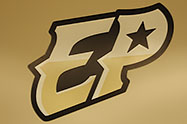
|
Ballpark Stats |
|---|
| Team: El Paso Chihuahuas of the Pacific Coast League |
| Award: BaseballParks.com’s 15th annual Ballpark Of The Year. Read press release here. |
| First game: April 28, 2014, a 2-1 loss to Fresno in 13 innings |
| Capacity: 9,500, of which 7,200 are fixed seats. |
| Architect: Populous and MNK Architects |
| Construction: C.F. Jordan and Hunt |
| Price: $75 million |
| Home dugout: 3B side |
| Field points: Northeast |
| Playing surface: Tifway 419 Bermudagrass |
| Betcha didn’t know: Populous had never designed a pro ballpark for a site this small (less than six acres) |
You’ll find sculptures, such as the one featuring 1,000 translucent bats hanging in the entry rotunda. There are also fountains, mosaics and numerous oil paintings and prints on loan from Safeco Insurance Company’s private art collection. I guess you could say that the Mariners’ home was quite an artistic success.
Now there is a ballpark in America’s Southwest that is also an artistic triumph. Not only is there stained glass, sculptures and numerous paintings, its structure is a thing of beauty.
And it’s not overstating things to say that it is a masterpiece.
I introduce to you Southwest University Park, the home of El Paso’s new affiliated Minor League baseball team, the Chihuahuas. It’s also the winner of the 15th annual Baseballparks.com Ballpark of the Year award.
The history of pro ball in the western tip of Texas has included quite a few ups and downs. Historians point to the El Paso Browns of around 1891 as the City’s first true team. Three decades later, many barred players from the Chicago “Black Sox” scandal took up residence to play for the City.
El Paso pro teams played in the Copper League, the Arizona-Texas League, the Arizona State League, the Mexican National League, the Southwest International League and the West Texas-New Mexico League. Along the way, there would be gaps of several years where there was no team in El Paso, but then a new league would pop up, and “play ball” would again be heard. For most of these teams, their home venue was Dudley Field, which was built in 1924.
A real turning point occurred in 1961, when the El Paso Sun Kings joined first the Class D Sophomore League, then the Double-A Texas League, where they played with only a one-year break until 2004. Along the way, the team changed its name to the Diablos, and they abandoned dilapidated Dudley Field — which was often derisively called “the Dudley Dome” — after the 1989 season. In 1990, the franchise moved into shiny, new Cohen Stadium, which had been constructed in the extreme northeast corner of the City. At first, things were grand, as the Diablos became the first Double-A team to hit the 300,000 attendance mark. However, new team ownership stopped many popular promotions and maintenance of the ballpark began to drop off. So did the crowds. In the years following 2000, the Diablos finished closer to the bottom of the League in attendance than the top, and by 2004, the team was next to last. And then the unthinkable happened.
I started hearing from various folks in Springfield, Missouri in 2001. They all said a really wealthy resident of Springfield was going to build a big, beautiful ballpark, and he was going to bring Double-A baseball to town. I politely responded to all of them that I doubted it, mostly because they weren’t close to the three existing Double-A leagues. I went so far as to ask Tom Kayser, the longtime President of the Texas League, if there was any chance of his league moving into Missouri. He told me that he had also heard from the Springfield folks. “I told them that they’d have to buy one of our existing franchises, but they are all established in their current cities and ballparks, so none are for sale. Besides, it’s outside the footprint of our league.”
As chronicled in my in-depth review of Hammons Field, our Ballpark of the Year for 2005, the Springfield folks were quite determined. And when they convinced the St. Louis Cardinals to purchase the El Paso Diablos, they did indeed have a franchise to move into their beautiful ballpark.
|
The Dudley Dome |
|---|
 |
| The home of El Paso’s various baseball teams from 1924 through 1989 was Dudley Field. Built a little bit east of the City’s business district, its flat grandstand made it difficult to modernize. In its last decade of use, it was mockingly referred to as the Dudley Dome, because it couldn’t have been less modern. |
The ballpark built by multi-millionaire John Q. Hammons was indeed fantastic — and he humbly named it after himself. The Springfield Cardinals are still going strong in southwest Missouri today.
But that left a gaping hole in El Paso. They had a big, expensive ballpark, but no affiliated team to play in it. Independent league baseball then came to Cohen, first with the Central Baseball League, then the American Association. There were some large crowds at Cohen during these years, but eventually the money-losing franchise was sold to a Native American tribe who planned to move them out of town.
El Paso, which was by far the largest market in the U.S. without an MLB or affiliated Minor League team, was mentioned as a possible landing spot when the Portland Beavers were forced to leave Oregon in 2010 and when the Omaha Royals were being evicted from Rosenblatt Stadium that same year. But with no viable ballpark, there was no reason for an affiliated team to relocate there.
The owners of the Beavers hoped to move the team to Escondido, CA, not far from San Diego, the home of the team’s Major League parent. When a deal for a ballpark there fell through, the franchise landed in Tucson and adopted their parent team’s name, the Padres. The move was due to the presence of a big-time — and unused — ballpark more than the desire to make southern Arizona their permanent home.
That’s when two families joined forces to make something happen. Woody Hunt (an El Paso resident and member of the El Paso Business Hall of Fame) and his son Josh, both board members at Hunt Companies, teamed up with Paul Foster and his wife Alejandra de la Vega Foster. They formed MountainStar Sports Group LLC in 2012, and its goal was to buy the Tucson Padres and move them to El Paso. However, if the City wouldn’t agree to build a ballpark by 2014, the group was going to abandon its plans all together.
This was an understandable strategy, because without a deadline, this could’ve dragged on for years, causing the cost of the stadium to skyrocket and the cost of operating a lame-duck franchise in Tucson to be monumental.
In September 2012, the City Council approved the project and set a budget for it of $52 million. At roughly the same time, City Engineer Alan Shubert was assigned to the stadium initiative full time. Both of these moves proved to be critical to the success of the project.
|
Too far north |
|---|
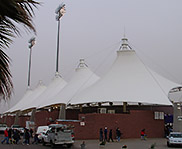 |
| Quite the modern marvel when it opened in 1990, Cohen Stadium was built a dozen miles north of downtown El Paso. It’s shown here during a game in 2003 as a sand storm was blowing through. Cohen lost its Texas League team after the 2004 season. Affiliated ball didn’t return to the market until a new park was built 12 miles to the south. |
Shubert summarized the situation this way: “We had the opportunity to land baseball, put it downtown and drive economic development there. Thankfully, the City Council was progressively minded to do that.” He added that the City had formulated a downtown plan in 2006, because it realized it was about a decade behind other cities of a similar size in the use of its downtown area. There were too many abandoned buildings and not much economic development on the drawing board. “In other cities I looked at — Oklahoma City, Tulsa, Reno, Columbus, Ohio and others — a new ballpark had revitalized development.” Why not in El Paso, too?
Even with the City Council’s approval of the ballpark project, there were problems. Once the site was selected (see below), all kinds of issues emerged. “Our site is unique,” Shubert explained. “It has slopes on both sides. It’s small, which meant the ballpark had to be built higher and we had to take lanes from the streets around it. We also had to relocate a dozen utilities. That means money.”
Another problem? Elections had taken place since 2012, and the make-up of the City Council wasn’t the same. It was a hard sell, but in June 2013, the Council finally agreed to increase the budget for the ballpark to $64 million. “‘And not one penny more’ was what the mayor said at the time,” Shubert recalled with a chuckle.
It became apparent rather quickly that even $64 million wasn’t going to be enough. Any additional expenditures were going to have to come from the team. “You know, when we first met with MountainStar, we set the goal of building the best ballpark in the country. Even when MountainStar had to start paying (when the $64 million budget was exceeded), they never varied from that original goal of having the best ballpark.” In other words, the owners readily agreed to enhancements and first-class amenities for the ballpark, even when the final tally of $75 million meant that their share of the cost was $11 million.
|
A name |
|---|
| A month before the opening of the PCL season, the Chihuahuas announced that a naming-rights deal had been struck with a local college. Henceforth, the ballpark would be called Southwest University Park. The educational institution, fairly new on the scene (having been accredited in 2012), commited to a 20-year agreement. Financial terms were not disclosed by either party. |
There were also problems in the summer of 2013 with the issuing of bonds to finance the construction. Interest rates shifted, and the bonds initially didn’t attract investors. This forced the City to increase the interest that the bonds would pay.
It would be nice to say that there was a happy ending, and that 24-hour shifts got the ballpark done in the nick of time … but that’s not exactly what happened. “The team always wanted the first game to be April 11,” said Shubert. Indeed, the Pacific Coast League schedule called for El Paso to have home games on April 11, 12, 13 and 14 of 2014. It wasn’t ready then, and the team played the series back in Tucson, splitting the four games with Reno before respectable crowds.
When the original opening date was missed, did that cause the City or construction companies to owe penalty payments to the team? No. “Since October of 2013, the City was committed to the date of April 28,” Shubert explained. “The agreement called for ‘substantial completion’ to be by that date. If this were a house we were talking about, ‘substantial completion’ means you can move into the house and cook on the stove.”
Indeed, on April 28, the Chihuahuas played the inaugural game at Southwest University Park. Yes, the stoves worked.
Even though it was two weeks later than the desired opening date, did the franchise make a wise move coming to downtown El Paso? Read on, as we look at the new ballpark’s setting, exterior, interior and game-day amenities. And what about all that art? Do all of these aspects of the park add up to winning the Ballpark of the Year honor?
The Setting
As was the case in Charlotte, there was no desire to repeat the mistake of the past. No, neither city wanted its new park way out in the ‘burbs. Only downtown would do.
In El Paso’s case, somewhat of a renaissance was taking place in its aging downtown. In the sliver land between the Franklin Mountains and the Rio Grande River was a collection of older buildings, including some that were abandoned or were about to be. There was also a theater/arts district that was just a few blocks from an emerging nightlife scene. In the middle was the City’s convention center and municipal theater.
All the ingredients were there for a fantastic ballpark site … except one: adequate size.
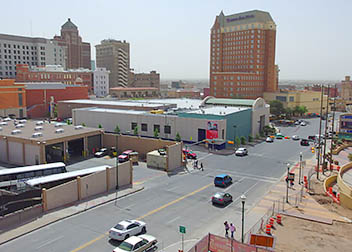 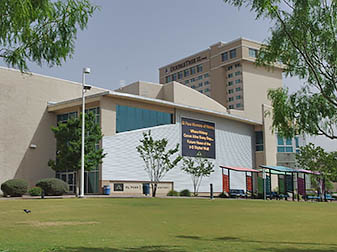 |
The desired site used to contain two buildings — El Paso’s City Hall and the Insights Children’s Museum. Parking for the two facilities was in between. The City had outgrown its City Hall, so a new one was almost ready. The site was chosen almost by default. “It was the only site downtown big enough under one owner (the City)” said Shubert. “We wouldn’t have had time to buy parcels of lands from different owners to assemble what we needed and still meet the deadline (that the park had to be done by 2014).” In addition, its location could act as a bridge between the nightlife area to the west and the theaters (above left) and museums (above right) on the east. It all added up … except for the problem of size. It was only five acres.
“It is a small site, that’s for sure. This is by far the smallest site we’ve ever done (for a ballpark),” Mike Sabatini, a Principal at Populous, told me. “It really influenced how the ballpark was designed.”
This took some significant planning and execution. And the amazing thing is that the architects and City figured ways to cheat on all four sides of the site.
On the north side of the site (the one closest to Interstate 10), Missouri Avenue was a one-way street that once connected Santa Fe Street and Durango Street. The City Hall’s front entrance was on Durango. Well, Missouri Avenue is now closed to vehicles. A much skinnier version now carries only pedestrians. The photo on the left below shows what was once Missouri Avenue looking west. The Scottish Rite Temple is on the right of the shot, while the ballpark is on the left. In the photo in the center below, you’re looking east down this pedestrian walkway, with the ballpark on your right. In the right-hand photo below, these are are tenement buildings on Missouri Avenue running west from the stadium.
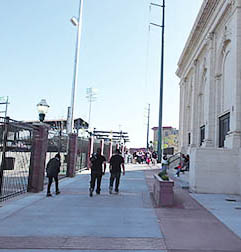 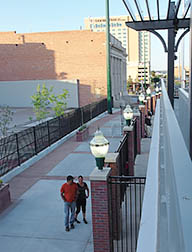 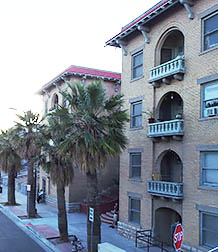 |
On Santa Fe, a travel lane was eliminated to give the ballpark site a bit a breathing room on its eastern edge. On the opposite side of Santa Fe from the ballpark are the El Paso Museum of History and right in front of it, Cleveland Square Park. The photo on the left below was taken from another, smaller park at the corner of Santa Fe and Missouri. Here you are looking at the exterior of the Chihuahuas’ new home from the middle of that park.
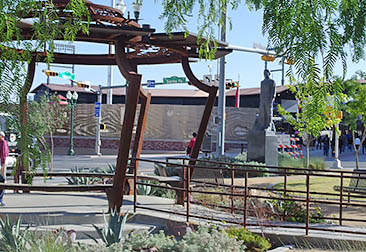  |
On the west side of the site is Durango Street, a steeply sloping overpass that carries cars over some surface streets and railroad tracks. Here, two of the four lanes were wiped out. Now pedestrians can walk from the developing nightlife area at the lower end of Durango up to the new ballpark using space that used to be for cars on this overpass. At the top of this bridge, the ballpark’s structure utilizes those same lanes (above right).
Eighteen months earlier, you would’ve been looking at the high-rise City Hall here.
That leaves the southern edge of the property. Here, Union Pacific railroad tracks carry quite a lot of train traffic. As the shot below left shows, the ballpark’s structure goes right up to the edge of this space … and farther around the building, a pedestrian ramp actually extends out over the tracks.
Talk about maximizing every square inch of space!
 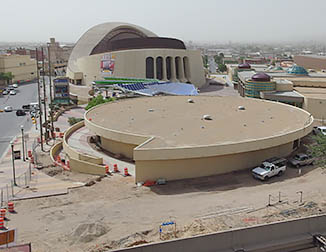 |
A couple of other “neighbors” to Southwest University Park deserve to be mentioned. First, directly across the concrete canyon (with the train tracks at the bottom) from the concourse along the right-field foul line is the city’s conventional hall and beyond it, the Abraham Chavez Theatre (both are shown above right). A pedestrian walkway connecting the ballpark’s concourse and a pathway next to the convention center is supposed to be constructed by the ballpark’s second season. The pathway on the far side of the tracks is currently being built. Its purpose is to connect the theaters and convention center on Santa Fe with the clubs that are springing up near the lower part of Durango Street.
That nightlife area has a spectacular building of note. In addition to small restaurants and clubs springing up, there’s the El Paso Union Depot (the shot below was taken from the ballpark). This gorgeous building opened in 1906 and is on the National Register of Historic Places. And, yes, it still operates as an Amtrak station and a transit hub is very close by.
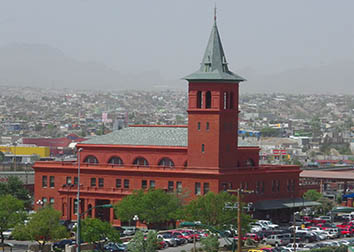 |
I should add that when you’re at the train station, you are about 800 feet from the fence that separates Juarez, Mexico from the United States.
In fact, everything you see in the smoggy background of the photo above is in fact in Juarez.
This is no small matter, as the Chihuahuas view this as a marketing opportunity. That’s because the population of the metro area on the Mexican side is around a million. The team hired a PR firm in Juarez to promote the Chihuahuas
and they advertise often on Spanish language radio stations. In a clever press event, the team’s mascot Chico received a passport so he could go back and forth across the border! Even the team’s nickname might be related to the Mexican geography as the state in which Juarez is located is, yes, Chihuahua.
The Exterior
 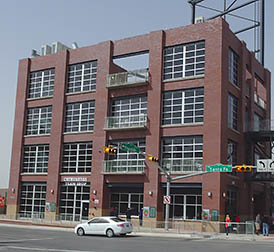 |
Because most of the parking is on the west side of the ballpark, that’s where you’re most likely to enter, so let’s start our look there. Franklin Avenue is a main street in that part of downtown. Prior to the City Hall being constructed here, the street ran though the middle of this parcel of land. Not any more.
“We constructed two stand-alone buildings in right field (see the two photos above), and we positioned these to frame the entrance (between them),” said Sabatini. “If you’re driving toward the ballpark on Franklin, you can see into the field all the way to home plate.” The shot on the left below was actually taken from the middle of Franklin Avenue to illustrate Sabatini’s point.
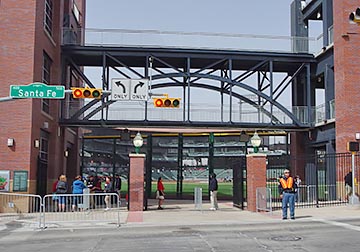 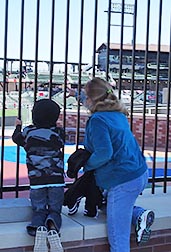 |
To the right of these buildings, running up to the corner of Santa Fe and Missouri and wrapping around the ballpark’s perimeter to left field is an iron fence (above right). The view inside the park is intentionally left wide open so those on the outside can look longingly at the park’s beautiful interior.
At the point in the fence that is farthest from home plate, a different material was used … and this is the first example of the incredible “art” in the ballpark. Ball-Nogues Studio in Los Angeles created the aluminum wall shown on the left side below. Titled “Not Whole Fence,” its pattern is meant to evoke wooden walls that used to form outfield fences through which kids could sneak a peak through knotholes. This piece is particularly spectacular at night.
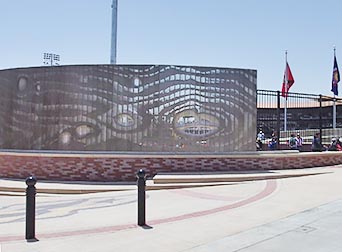 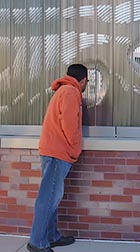 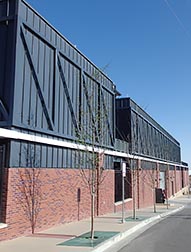 |
The photos of the various buildings surrounding the new ballpark (in The Setting section) are important for you to see because they relate directly to the exterior of the Chihuahuas’ home. As was the case with Charlotte’s new park, the colors of the bricks used were anything but random.
“The railroad depot is (made of) a light red brick,” Sabatini points out. “Just on the other side of the Interstate is a large cathedral that has a darker brick. On the depot side (of the park), we used 60% red brick and 40% of this dark brick. On the side of the Cathedral, the Santa Fe side, we reversed that, going 60/40 the other way.” And you thought the masons just picked up any brick that was handy.
The park’s environment also influenced the choice of construction materials in another way. Explained Sabatini, “The Union Pacific railroad is a prominent focus in El Paso as well as being a major employer there, so we used the motif of a boxcar (see above right), using the metal panel of one. We actually used the structure of a boxcar to design the diagonal braces across (the panels).”
 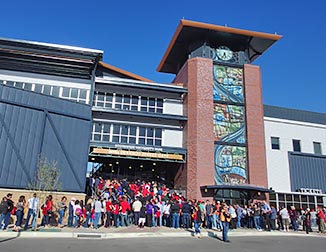 |
Wait! There’s one more factor to divulge. “El Paso for the longest time was known for its copper manufacturing and smelting,” continued Sabatini. “It’s not a true copper metal — it’s a copper color — we used for the roof (above left). We wanted to tie back to the history of smelting in the area.”
This leaves one more part of the exterior to describe — and it’s the best. The side of the ballpark surrounding the Durango Street Gate (above right) is spectacular, stunning, gorgeous …. and, yes, artistic.
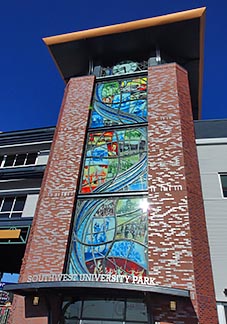 |
Unless fans take public transportation to the Union Plaza Transit Terminal at the bottom of the Durango Street overpass, they aren’t likely to see this side of the park. That is truly a shame.
Along this side is the outside entrance to the souvenir shop, ticket windows and steps that lead to the gates right on the main concourse.
The high point –both literally and figuratively — of this beautiful side of the park is the tower that has the VIP entry at its base and an elevator within. Again, with a nod to the adjacent railroad tracks, Sabatini points out that this is meant to resemble a railroad switching tower, similar to the tower at lovely Dickey-Stephens Park in Arkansas. That’s a ballpark that also utilizes a train motif.
The clock at the top of the tower actually came from the Insights Museum that was demolished on this site to make way for the ballpark.
Ahh, but this tower has something not found elsewhere: a stained-glass mural called “River Chronicle: History of El Paso.” Roberto Davidoff of El Paso’s Signature Architectural Elements produced this true work of art. Cindy Graff Cohen, columnist for the El Paso Inc. newspaper, described it beautifully:
El Paso’s story is told in stained glass on the 60-foot clock tower, beginning with images of 1,000-year-old Hueco Tank petroglyphs at the bottom and ending with a contemporary cityscape at the top. In between are 21 images taken from archival photos and illustrations that show key people and places, from the Tiguas and conquistadors, to Fort Bliss and Texas Western’s 1966 NCAA championship basketball team … (and) a stylized Rio Grande flows through the three large panels …
The stained glass is mesmerizing. You should make a point of visiting this side of the ballpark if you attend a Chihuahuas game.
Now let’s look inside Southwest University Park.
